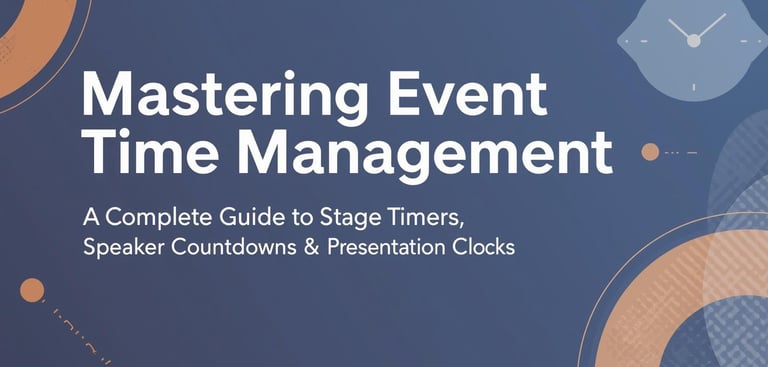Start sending invites for free - no card required - Click here
A Complete Guide to Stage Timers, Speaker Countdowns & Presentation Clocks
Time is one of the most valuable assets in event planning. Whether you're managing a multi-track conference, a virtual webinar, or a stage program with multiple presenters, keeping everything on schedule is critical. This is why modern event planners rely on structured timing methods such as a stage timer, a countdown timer for sessions, or a conference timer to keep programs running smoothly.
BLOGS
11/20/20253 min read


Time is one of the most valuable assets in event planning. Whether you're managing a multi-track conference, a virtual webinar, or a stage program with multiple presenters, keeping everything on schedule is critical. This is why modern event planners rely on structured timing methods such as a stage timer, a countdown timer for sessions, or a conference timer to keep programs running smoothly.
This blog explores how timers help streamline events, maintain audience engagement, and support speakers in delivering powerful presentations all without technical jargon or promotion of any specific tools.
Why Timing Makes or Breaks an Event
Every event, no matter its scale, runs on a carefully organized schedule. When time slips out of control, the event quickly becomes stressful for organizers and confusing for attendees. Sessions that run late cause delays in transitions, disrupt audience flow, and sometimes even force program changes.
Using structured guidance like a timer for presenters or a countdown timer for stage allows everyone involved to maintain clarity throughout the event. When speakers know how much time is left, they adjust their pacing naturally, and when organizers monitor the clock efficiently, everything aligns with the planned agenda.
Types of Timers Used in Events
1. Stage Timers
A stage timer is commonly used in conferences, award shows, and summits. It sits where presenters can see it clearly, helping them stick to their allotted time. These timers often display:
Time remaining
Visual warnings
Color-coded status indicators
They help presenters avoid overruns and maintain the professionalism of the event.
2. Countdown Timers for Sessions
A countdown timer for sessions helps organizers coordinate transitions between multiple segments such as:
Keynotes
Breakout rooms
Breaks
Workshops
For events with multiple tracks or parallel activities, this type of timing system becomes invaluable.
3. Presentation Timers
Speakers often need a timer for presentation to pace themselves effectively. Even the most experienced presenters sometimes lose track of time when interacting with the audience, so using a countdown timer for presentation ensures content delivery stays polished and purposeful.
4. Speaker Timers
A timer for speakers or countdown timer for speakers ensures fairness and equality among all presenters. This is especially important during:
Panel discussions
Pitch sessions
Competitions
Debates
With multiple voices competing for attention, staying within time is crucial.
5. Webinar Timers
Virtual events require precise coordination. A webinar timer or countdown timer for webinar helps presenters maintain timing despite possible technical delays or participant distractions.
Since online attendees have shorter attention spans, adhering to time structure keeps engagement high.
6. Multi-Event Countdown Timers
For larger programs such as conferences, expos, and multi-session summits, organizers rely on a countdown timer for events to manage the full agenda. These timers help maintain discipline between tracks and ensure seamless movement from one segment to the next.
Why Timers Matter for Speakers
Speakers often fear running out of time or finishing too early. Effective timing helps them:
Deliver content confidently
Pace storytelling and explanations
Manage audience interaction
Avoid rushed conclusions
Maintain the event schedule
A visible timer for presenters gives speakers peace of mind and improves delivery quality.
Why Timers Matter for Organizers
For planners, timing ensures:
Sessions start and end on time
Transitions are smooth
Attendees experience a polished event
Using a conference timer allows behind-the-scenes staff to synchronize multiple event elements like lighting, stage movement, and AV cues.
Why Timers Matter for Audiences
Attendees appreciate punctuality. Proper timing ensures:
Predictable schedules
Breaks occur as planned
Long sessions don’t feel overwhelming
A well-timed event maintains energy and engagement.
Real-Life Scenarios Where Timers Are Critical
1. Conferences
With multiple speakers, tracks, and activities, a conference relies heavily on timers like a countdown timer for stage to maintain structure.
2. Webinars
Virtual attendees have the option to leave at any moment. A countdown timer for webinar reduces drop-off by helping presenters stay focused.
3. Corporate Events
Whether it’s training, presentations, or annual meetings, timing ensures employees and leadership get maximum value.
4. Live Performances
Timing controls transitions, technical cues, and audience experience.
Best Practices for Using Timers
1. Provide Time Guidelines Beforehand
Speakers should know whether they have 10, 20, or 40 minutes, allowing them to plan accordingly.
2. Rehearse with Timers
Encourage presenters to rehearse with a timer for presentation to understand pacing.
3. Keep Timers Visible
A timer hidden behind equipment defeats its purpose.
4. Use Clear Warnings
Color transitions (green → yellow → red) help presenters stay aware without verbal cues.
5. Add Time Buffers
Build slight gaps between sessions to avoid cascading delays.
Conclusion
Time is a silent hero behind every well-organized event. Whether it’s a simple meeting, a webinar, or a large conference, timing tools like a timer for speakers and a countdown timer for events ensure smooth execution, respectful pacing, and an enjoyable experience for everyone involved.
Well-managed timing transforms an event from chaotic to exceptional, proving that time, when controlled well, is one of the greatest assets in event management.
BulkCalendar.in
Send Bulk & Mass Calendar Invites Instantly
Contact us
Engagement
sales@letscalendar.com
+44 (0) 203 916 5117
© 2025. All rights reserved.
Help?
